Gi-Hwan Shin
Towards Personalized Brain-Computer Interface Application Based on Endogenous EEG Paradigms
Nov 18, 2024


Abstract:In this paper, we propose a conceptual framework for personalized brain-computer interface (BCI) applications, which can offer an enhanced user experience by customizing services to individual preferences and needs, based on endogenous electroencephalography (EEG) paradigms including motor imagery (MI), speech imagery (SI), and visual imagery. The framework includes two essential components: user identification and intention classification, which enable personalized services by identifying individual users and recognizing their intended actions through EEG signals. We validate the feasibility of our framework using a private EEG dataset collected from eight subjects, employing the ShallowConvNet architecture to decode EEG features. The experimental results demonstrate that user identification achieved an average classification accuracy of 0.995, while intention classification achieved 0.47 accuracy across all paradigms, with MI demonstrating the best performance. These findings indicate that EEG signals can effectively support personalized BCI applications, offering robust identification and reliable intention decoding, especially for MI and SI.
Multi-Signal Reconstruction Using Masked Autoencoder From EEG During Polysomnography
Nov 14, 2023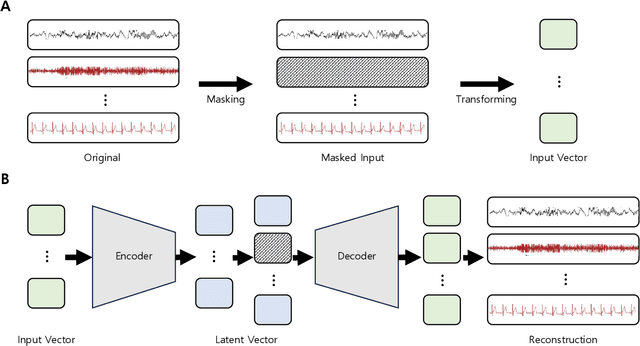
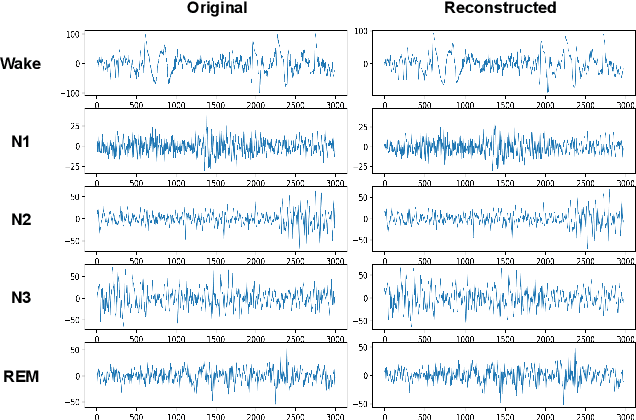
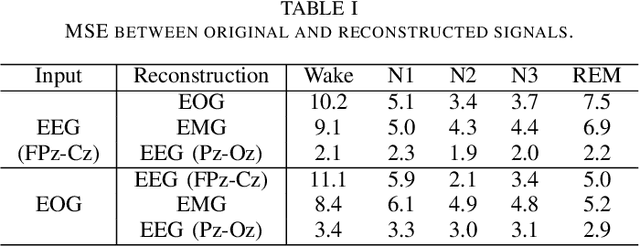
Abstract:Polysomnography (PSG) is an indispensable diagnostic tool in sleep medicine, essential for identifying various sleep disorders. By capturing physiological signals, including EEG, EOG, EMG, and cardiorespiratory metrics, PSG presents a patient's sleep architecture. However, its dependency on complex equipment and expertise confines its use to specialized clinical settings. Addressing these limitations, our study aims to perform PSG by developing a system that requires only a single EEG measurement. We propose a novel system capable of reconstructing multi-signal PSG from a single-channel EEG based on a masked autoencoder. The masked autoencoder was trained and evaluated using the Sleep-EDF-20 dataset, with mean squared error as the metric for assessing the similarity between original and reconstructed signals. The model demonstrated proficiency in reconstructing multi-signal data. Our results present promise for the development of more accessible and long-term sleep monitoring systems. This suggests the expansion of PSG's applicability, enabling its use beyond the confines of clinics.
Development of Personalized Sleep Induction System based on Mental States
Dec 12, 2022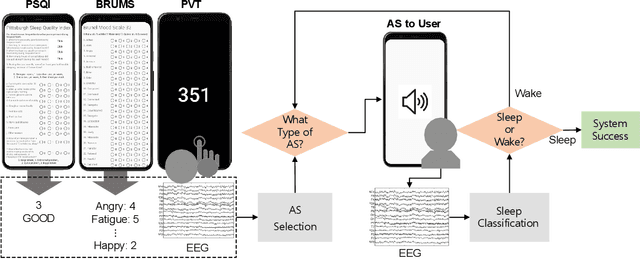
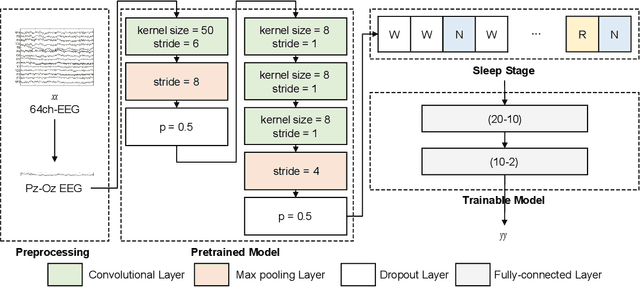
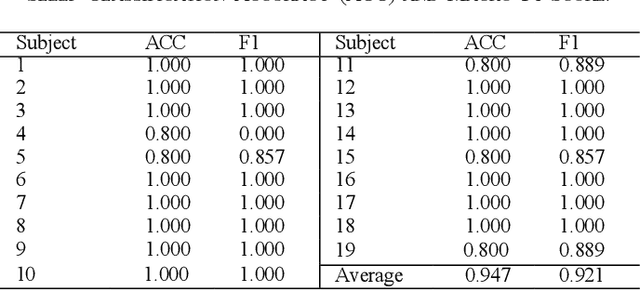
Abstract:Sleep is an essential behavior to prevent the decrement of cognitive, motor, and emotional performance and various diseases. However, it is not easy to fall asleep when people want to sleep. There are various sleep-disturbing factors such as the COVID-19 situation, noise from outside, and light during the night. We aim to develop a personalized sleep induction system based on mental states using electroencephalogram and auditory stimulation. Our system analyzes users' mental states using an electroencephalogram and results of the Pittsburgh sleep quality index and Brunel mood scale. According to mental states, the system plays sleep induction sound among five auditory stimulation: white noise, repetitive beep sounds, rainy sound, binaural beat, and sham sound. Finally, the sleep-inducing system classified the sleep stage of participants with 94.7 percent and stopped auditory stimulation if participants showed non-rapid eye movement sleep. Our system makes 18 participants fall asleep among 20 participants.
Mobile BCI dataset of scalp- and ear-EEGs with ERP and SSVEP paradigms while standing, walking, and running
Dec 08, 2021


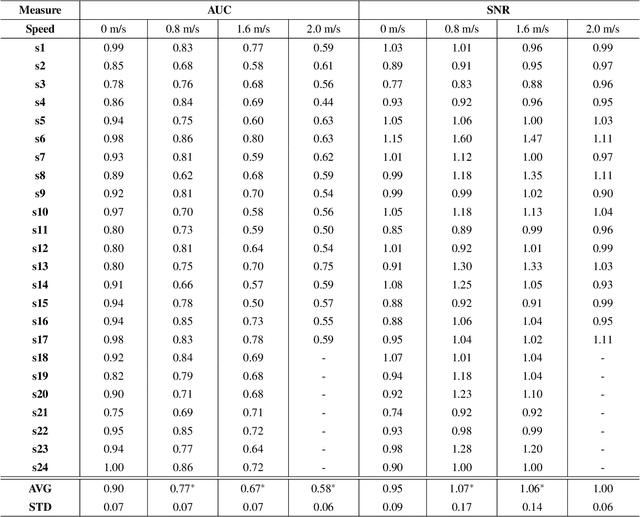
Abstract:We present a mobile dataset obtained from electroencephalography (EEG) of the scalp and around the ear as well as from locomotion sensors by 24 participants moving at four different speeds while performing two brain-computer interface (BCI) tasks. The data were collected from 32-channel scalp-EEG, 14-channel ear-EEG, 4-channel electrooculography, and 9-channel inertial measurement units placed at the forehead, left ankle, and right ankle. The recording conditions were as follows: standing, slow walking, fast walking, and slight running at speeds of 0, 0.8, 1.6, and 2.0m/s, respectively. For each speed, two different BCI paradigms, event-related potential and steady-state visual evoked potential, were recorded. To evaluate the signal quality, scalp- and ear-EEG data were qualitatively and quantitatively validated during each speed. We believe that the dataset will facilitate BCIs in diverse mobile environments to analyze brain activities and evaluate the performance quantitatively for expanding the use of practical BCIs.
Automatic Micro-sleep Detection under Car-driving Simulation Environment using Night-sleep EEG
Dec 10, 2020



Abstract:A micro-sleep is a short sleep that lasts from 1 to 30 secs. Its detection during driving is crucial to prevent accidents that could claim a lot of people's lives. Electroencephalogram (EEG) is suitable to detect micro-sleep because EEG was associated with consciousness and sleep. Deep learning showed great performance in recognizing brain states, but sufficient data should be needed. However, collecting micro-sleep data during driving is inefficient and has a high risk of obtaining poor data quality due to noisy driving situations. Night-sleep data at home is easier to collect than micro-sleep data during driving. Therefore, we proposed a deep learning approach using night-sleep EEG to improve the performance of micro-sleep detection. We pre-trained the U-Net to classify the 5-class sleep stages using night-sleep EEG and used the sleep stages estimated by the U-Net to detect micro-sleep during driving. This improved micro-sleep detection performance by about 30\% compared to the traditional approach. Our approach was based on the hypothesis that micro-sleep corresponds to the early stage of non-rapid eye movement (NREM) sleep. We analyzed EEG distribution during night-sleep and micro-sleep and found that micro-sleep has a similar distribution to NREM sleep. Our results provide the possibility of similarity between micro-sleep and the early stage of NREM sleep and help prevent micro-sleep during driving.
Predicting the Transition from Short-term to Long-term Memory based on Deep Neural Network
Dec 07, 2020



Abstract:Memory is an essential element in people's daily life based on experience. So far, many studies have analyzed electroencephalogram (EEG) signals at encoding to predict later remembered items, but few studies have predicted long-term memory only with EEG signals of successful short-term memory. Therefore, we aim to predict long-term memory using deep neural networks. In specific, the spectral power of the EEG signals of remembered items in short-term memory was calculated and inputted to the multilayer perceptron (MLP) and convolutional neural network (CNN) classifiers to predict long-term memory. Seventeen participants performed visuo-spatial memory task consisting of picture and location memory in the order of encoding, immediate retrieval (short-term memory), and delayed retrieval (long-term memory). We applied leave-one-subject-out cross-validation to evaluate the predictive models. As a result, the picture memory showed the highest kappa-value of 0.19 on CNN, and location memory showed the highest kappa-value of 0.32 in MLP. These results showed that long-term memory can be predicted with measured EEG signals during short-term memory, which improves learning efficiency and helps people with memory and cognitive impairments.
Assessment of Unconsciousness for Memory Consolidation Using EEG Signals
May 15, 2020



Abstract:The assessment of consciousness and unconsciousness is a challenging issue in modern neuroscience. Consciousness is closely related to memory consolidation in that memory is a critical component of conscious experience. So far, many studies have been reported on memory consolidation during consciousness, but there is little research on memory consolidation during unconsciousness. Therefore, we aim to assess the unconsciousness in terms of memory consolidation using electroencephalogram signals. In particular, we used unconscious state during a nap; because sleep is the only state in which consciousness disappears under normal physiological conditions. Seven participants performed two memory tasks (word-pairs and visuo-spatial) before and after the nap to assess the memory consolidation during unconsciousness. As a result, spindle power in central, parietal, occipital regions during unconsciousness was positively correlated with the performance of location memory. With the memory performance, there was also a negative correlation between delta connectivity and word-pairs memory, alpha connectivity and location memory, and spindle connectivity and word-pairs memory. We additionally observed the significant relationship between unconsciousness and brain changes during memory recall before and after the nap. These findings could help present new insights into the assessment of unconsciousness by exploring the relationship with memory consolidation.
 Add to Chrome
Add to Chrome Add to Firefox
Add to Firefox Add to Edge
Add to Edge